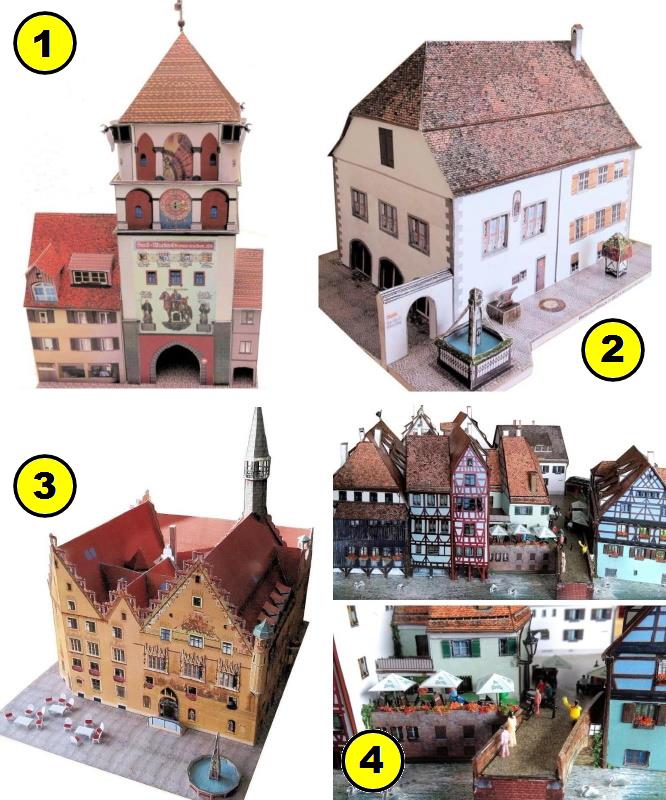This papercraft of a candy shop known in Japan as Dagashi is offered by Japanese website Retro Machine Club.
There you will find the paper model of the store and another model of the store's interior, but the two are not to the same scale and do not look like they were made to match.
What I did was combine the two models, leaving them on the same scale and I also made changes to the building, as it was very low and this would make it difficult to see the inside of the shop.
I opened the front of the building, leaving the characteristic sliding doors on the sides and also changed the external textures, using material from other models offered on the website itself.
I included more posters and a door at the back of the building. Another thing I did was to separately highlight the nice lady who seems to be the owner of the establishment, as in the original papercraft she was just printed in the background of the scene.
Finally, I used more textures from the model itself to emulate the cards of sweets and toys that usually hang in front of the Dagashis.
I gathered everything on a single sheet of paper, so you can imagine that the model, once assembled, will be very small, suitable for decorating your work desk or bookshelf.
In addition to the link to this model, I will also leave the link to Retro Machine Club website so that you can download the original versions and many other papercrafts there.
Japanese stores known as Dagashi are popular for selling a wide variety of traditional Japanese sweets and snacks at affordable prices.
The word "dagashi" means "cheap sweets" in Japanese, and these stores were popular among children in Japan from the 1950s to the late 80s.
Dagashi stores offer a wide variety of sweets, snacks, chewing gum, and drinks, many of which are unique to Japan or difficult to find elsewhere.
They are often sold in small, colorful and attractive packaging, often with anime or manga characters on the packaging.
The prices of dagashi products are generally very low, with many items costing only a few yen. Because of this, dagashi stores have become known as a fun and affordable place for children to buy sweets with their pocket money.
Although dagashi stores have been less popular in recent decades, they continue to be an icon of Japanese sweets and snacks culture and an important part of many Japanese childhoods.
Some establishments still exist, and many dagashi sweets and snacks can also be found in supermarkets and convenience stores throughout Japan.
Este papercraft de uma lojinha de doces conhecida no Japão como Dagashi é oferecido pelo site japonês Retro Machine Club.
Lá você vai encontrar o modelo de papel da loja e outro modelo do interior da loja, mas os dois não estão na mesma escala e não parecem ter sido feitos para combinarem.
O que eu fiz foi combinar os dois modelos, deixando-os na mesma escala e também fiz alterações no prédio, já que ele era muito baixo e isso dificultaria ver o interior da lojinha.
Abri a frente do prédio deixando nas laterais as características portas de correr e ambém mexi nas texturas externas, usando material de outros modelos oferecidos no próprio site. Incluí mais posters e uma porta na parte de trás do prédio.
Outra coisa que fiz foi destacar em separado a simpática senhora que parece ser a dona do estabelecimento, pois no papercraft original ela era apenas estampada no fundo do cenário.
Por fim usei mais texturas do próprio modelo para emular as cartelas de doces e brinquedinhos que geralmente ficam penduradas na frente das Dagashis.
Reuni tudo em uma única folha de papel, então você pode imaginar que o modelo depois de montado será bem pequeno, próprio para decorar sua mesa de trabalho ou estante.
Além do link para este modelo, também deixarei o link do site Retro Machine Club para que vocês possam baixar as versões originais e muitos outros papercrafts que tem lá.
As lojas japonesas conhecidas como Dagashi são populares por venderem uma grande variedade de doces e guloseimas tradicionais japonesas a preços acessíveis.
A palavra "dagashi" significa "doces baratos" em japonês e essas lojas eram populares entre as crianças no Japão desde a década de 1950 até o final dos anos 80.
As lojas dagashi oferecem uma grande variedade de doces, salgadinhos, chicletes e bebidas, muitos dos quais são exclusivos do Japão ou difíceis de encontrar em outros lugares.
Eles costumam ser vendidos em pequenas embalagens coloridas e atraentes, muitas vezes com personagens de anime ou mangá em sua embalagem.
Os preços dos produtos dagashi são geralmente muito baixos, com muitos itens custando apenas alguns ienes.
Por causa disso, as lojas dagashi se tornaram conhecidas como um lugar divertido e acessível para as crianças comprarem guloseimas com o dinheiro da mesada.
Embora as lojas dagashi tenham sido menos populares nas últimas décadas, elas continuam a ser um ícone da cultura de doces e guloseimas japonesas e uma parte importante da infância de muitos japoneses.
Alguns estabelecimentos ainda existem, e muitos dos doces e guloseimas dagashi também podem ser encontrados em supermercados e lojas de conveniência em todo o Japão.
Link to Dagashi Shop: Dagashi.Shop.Miniature.Custom.Paper.Model.by.Retro.Machine.Club
More Architectural Paper Models related posts:































